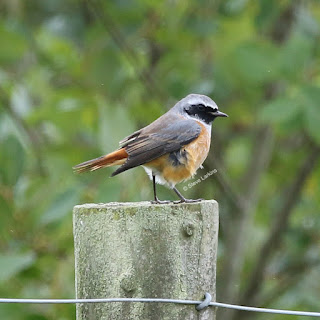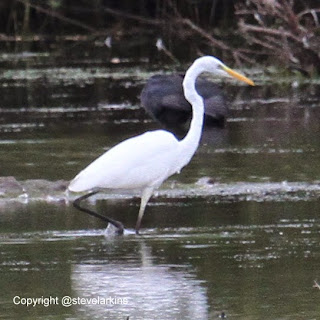After several extremely frustrating failed attempts a week or two ago, I finally managed to get a glimpse of one of the UK's rarest winter visitors - a Great Grey Shrike. A lifer for me!
A big thank you to the Bracknell birders who helped provide much needed directions. I parked up at the Rowbarge Pub in Woolhampton and walked around the west side of the Gravel Pits. The bird has quite a large territory and currently it is using the fields and hedges just north of Wasing Road, Brimpton.
It was initially spotted on the power lines and then started hunting in the fields, resting atop a Hawthorn bush, where I managed to get this picture. There was very poor light this afternoon, which is fairly typical of November in the UK!
Greenham Birding
Thursday, 12 November 2015
Friday, 25 September 2015
Whinchat on Migration
It was a really nice Autumn day today, so I popped up onto Greenham Common in search of the Yellow Wagtails which were reported on Berks Birds yesterday.
Although there were no signs of the Wagtails, I was delighted to spot a pair of Whinchats feeding in small gorse bushes, just on the western edge of the runway.
Whinchats are migrating back to Africa and are passing through Berkshire from their breeding ground in northern and western England.
Although there were no signs of the Wagtails, I was delighted to spot a pair of Whinchats feeding in small gorse bushes, just on the western edge of the runway.
Whinchats are migrating back to Africa and are passing through Berkshire from their breeding ground in northern and western England.
Tuesday, 1 September 2015
Male Redstart on Greenham Common (Sep 2015)
After spending over a frustrating hour and a half today, looking in vain for Wheatears, I finally got lucky and spotted this beautiful male Redstart. It was showing really well, flying down, catching insects, then returning to the same fence post where it sat for quite some time.
Redstarts are beautiful birds and I feel privileged to see one, on its Autumn migration back to Africa, from the breeding areas in Wales and the west country.
The bird was sat right on a post of the perimeter fence surrounding the bird ringing area on the western side of Greenham Common.
The pictures (left) were taken with a Canon 7D Mark II, with a Canon 300mm F2.8 IS II lens and a 1.4x extender - making 420mm focal length. This combo takes great pictures, although I probably would have done slightly better with the 2x extender, as the bird was about 80 feet away.
Redstarts are beautiful birds and I feel privileged to see one, on its Autumn migration back to Africa, from the breeding areas in Wales and the west country.
The bird was sat right on a post of the perimeter fence surrounding the bird ringing area on the western side of Greenham Common.
The pictures (left) were taken with a Canon 7D Mark II, with a Canon 300mm F2.8 IS II lens and a 1.4x extender - making 420mm focal length. This combo takes great pictures, although I probably would have done slightly better with the 2x extender, as the bird was about 80 feet away.
Friday, 26 September 2014
Great White Egret
It's not every day that one of the UK's rarest birds comes to Thatcham, so I thought I would stop by at Lea Farm, just off the A4 to take a peek at the Great White Egret which appears to have taken up residence there, for a few days at least!
The Great White Egret is unmistakeable; standing around 1m tall with a wingspan of 1.3 - 1.7m. It is around 30% larger than the Little Egret, its much more frequently seen cousin.
When I visited, the Egret was at the far end of the lake from the hide, so you will need binoculars and a long lens or decent Bridge Camera to take photographs. Even my DSLR and 100-400mm lens weren't really adequate. Unfortunately this morning was rather cloudy too, so high ISO was needed, which took the edge off the quality of my pictures.
The NDOC site provides a map. The grid reference is SU495665. This translates to GPS coordinates of 51.395385N and 1.2899073W, if you need to programme your sat nav.
The Great White Egret is unmistakeable; standing around 1m tall with a wingspan of 1.3 - 1.7m. It is around 30% larger than the Little Egret, its much more frequently seen cousin.
When I visited, the Egret was at the far end of the lake from the hide, so you will need binoculars and a long lens or decent Bridge Camera to take photographs. Even my DSLR and 100-400mm lens weren't really adequate. Unfortunately this morning was rather cloudy too, so high ISO was needed, which took the edge off the quality of my pictures.
How to find Lea Farm
Lea Farm can be reached by leaving the A4 (towards Newbury from Thatcham) onto Hambridge Road and taking the first exit at the mini-roundabout onto Hambridge Lane. Then follow the road straight on, until it becomes an unmade road. You'll then need to follow the brown signs for "bird hide".The NDOC site provides a map. The grid reference is SU495665. This translates to GPS coordinates of 51.395385N and 1.2899073W, if you need to programme your sat nav.
Wednesday, 10 September 2014
Wheatear Migration
With the summer over (and what a good one it was!) our attentions are now focused on the autumn migration.
I took a trip up to Walbury Hill, which at 974ft is the highest natural point in South East England and a good place to spot migrating Whinchat and Wheatear. It is located near Hungerford, West Berkshire.
No luck with the Whinchat today, but it was nice to see this friendly Wheatear posing for me on a post near to the westerly car park adjoining Combe.
Additional sightings at Combe were two Red Kites doing aerial acrobatics, a hunting Kestrel, 30+ swallows and a Meadow Pipit.
I took a trip up to Walbury Hill, which at 974ft is the highest natural point in South East England and a good place to spot migrating Whinchat and Wheatear. It is located near Hungerford, West Berkshire.
No luck with the Whinchat today, but it was nice to see this friendly Wheatear posing for me on a post near to the westerly car park adjoining Combe.
Additional sightings at Combe were two Red Kites doing aerial acrobatics, a hunting Kestrel, 30+ swallows and a Meadow Pipit.
Saturday, 8 March 2014
Pair of Nuthatches
It was on our feeder when I was out in the garden the other day and just looked at me as if to say 'I don't care about you, but thanks for the food'.
We have been getting a pair of Nuthatches for a while and it is always a pleasure to watch them. One will come into feed, closely followed by the other. They usually take as many sunflower hearts as they can and then fly off towards West Wood, Greenham - where we think they live. Hopefully we have helped them in the cold months of winter. A warm 15C here today, so Spring looks as if it has arrived early!
Friday, 7 March 2014
Bullfinches in our Greenham Garden
The reason fruit farmers sadly used to persecute Bullfinches was their taste for Spring buds, including those on budding apple trees. This practice is now thankfully outlawed.
This week I witnessed our almost resident male and female Bullfinch adding a tasty salad mix to their sunflower heart diet! Here is the male Bullfinch (looking particularly well fed I have to say!):
Subscribe to:
Comments (Atom)








